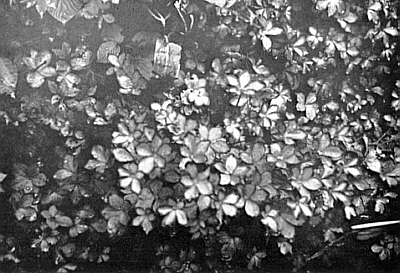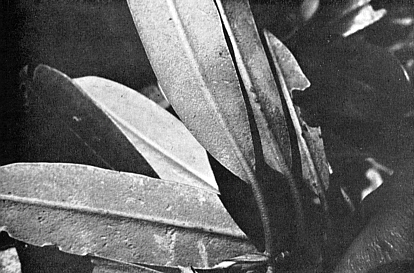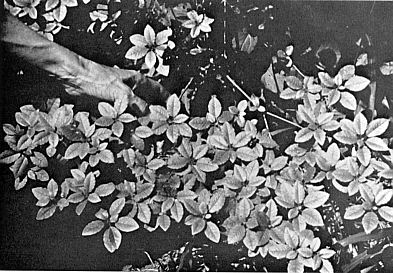QBARS - v24n3 Rhododendrons at Flowering Time, Japan, 1969 (conclusion)
Rhododendrons at Flowering Time: Japan, 1969
(conclusion)
Frank Doleshy, Seattle, Washington
The Sendai Area
Starting from Oki, we rode airplanes much of the day; first to Yonago, then to Saka, then to Tōkyō, and finally to Sendai, far north in the Tōhoku District. Waiting at the airport was Professor Dr. Sohma, of Tōhoku University, and this was the first time we'd been able to get together since our chance meeting at a small inn on Yakushima, in 1965. There was a great deal to talk about, and he picked up Mrs. Sohma and their daughter so that we could take our time at dinner and plan the next several days.
Agreeing that one more low-pressure day might be in order, Mrs. Doleshy and I picked up our rented car the next morning and drove north to famous Matsushima, or Pine Islands. Then we returned to the University and toured the Botanic Garden with Dr. Sohma. This huge hillside had been the castle forest of the lords who held power here for more than 500 years. Surely, at various times, trees have been cut. Also, many plants have been brought in, but much of the garden seems like virgin forest. The location is quite far north on the Pacific coast of Honshū a number of central Japan plants are near their northern limit, and these are overlapped by plants of the cold areas. The combined result is interesting, and it would have been instructive (but lazy) to make all of our north Japan tours within the boundaries of this garden.
Dr. Sohma was aware of our interest in the geographical limits of rhododendron distribution, and the first trip was to a rather low and ordinary looking mountain ridge called Mitake, in the far northwestern part of Miyagi Prefecture. This is the home of the most northern of the known populations of R. metternichii , which occurs here as var. pentamerum . (The obsolete but still familiar name for this variety was R. degronianum . In Japanese, it is known as AZUMA SHAKUNAGE, or just plain SHAKUNAGE.)
With Dr. Sohma's help we read the Ministry of Education's sign, pointing to the rhododendrons, and we felt that we were about to complete the initial, or elementary, part of our study of R. metternichii . In 1965 we had seen the southernmost plants on a Yaku Island mountain top, 1300 kilometers away ( R. metternichii var. yakushimanum , popularly, R. yakushimanum ), and we had examined populations in various parts of the intervening territory.
This philosophizing did not delay us long because there were rhododendrons all over the place, often as a nearly continuous shrub layer under the thick canopy of deciduous trees. Except for an occasional large rhododendron, all the vegetation had a second-growth appearance, as though burned off or otherwise denuded within the last several decades.
The rhododendrons were quite compact, generally up to one meter in height, and the foliage was healthy and deep-green, often with the same base-to-tip ridges as the Oki Island plants. Indumentum was thick, a yellow-buff color without any pink cast. New growth on small seedlings was reddish, as on var. hondoense , but we were too early to see new leaves on mature branches.
Flowers had been extremely sparse, with only 5 or 6 trusses of new capsules to be seen on all of the hundreds of plants we walked past. Considering this and the environmental conditions, we all felt that we were in a transitional plant community and that the understory of rhododendrons would be drastically thinned by die out as the shade became denser - eventually surviving as a relatively sparse component of the mature forest. The forthcoming period of hard times for the rhododendrons could probably be avoided if the tree canopy were thinned. Under present rules for this area, any such activity would be rewarded with 5 years in the penitentiary. But, if permission could be obtained, it would be interesting to experiment with a small plot.
The R. metternichii var. pentamerum was left behind as we approached the top of the ridge, possibly because of thicker soil which kept the root from the fairly porous bedrock (a metamorphic andesite lava which is exposed in a small area here but hardly anywhere else in the surrounding mountains). However, the shrub vegetation on the top of the ridge included R. semibarbatum (BAIKA TSUTSUJI), R. quinquefolium , and such other Ericaceous plants as Tripetaleia, Menziesia and Lyonia .
The next day Dr. Sohma had a class to meet, and he gave us careful directions for driving to Zaō. Many tourists go there to see the crater lake in the throat of a great explosive volcano (inactive for 330 years) and we started with this. It was surrounded by snow banks, but the ridges above were dry, with very sparse boreal vegetation, including thickets of R. brachycarpum in small dips and any other place where there was slight shelter from wind. These plants were low and compact, but were not reduced to creeping scrub: actually they were the most normal-looking shrubs on this treeless plateau of lava fragments.
The elevation here was about 1750 meters, and Dr. Sohma had recommended that we drive back down and take a trail through gentle slopes at the 1500-1600 meter level. We found this trail and, for the first time in Japan, encountered sub-alpine meadows of the type commonly seen in the Cascade Mountains of Washington. But the plants were different: 20 meters from the road, the trail passed under a magnificent R. albrechtii (MURASAKI YASHIO) in full bloom. These were visible near and far, in the more brushy spots. (FIG. 41).

|
|---|
Fig. 41. R. albrechtii in the sub-alpine meadows at Zao. |
R. brachycarpum , was probably the most common large shrub and looked much like those on the rocky ridge above, but grew to 1-½ m. tall. Foliage was dense and upturned, a pattern of growth usually but not always seen at high, exposed locations. Here, as at Yokodake in 1967 and at other places, we could see no indumentum with the naked eye. Flower buds (on June 11) were still tight and probably would not open for two or three weeks.
Even a hardened rhododendron specialist would have noticed some of the other plants here: fields of tiny, white Primula nipponica , clumps of white and yellow Geum , frilled, pink funnels of Shortia soldanelloides just opening, unfolding leaves of Viburnum furcatum at the purple-brown stage, and spectacular members of the Lily Family. Weather was magnificent, and it was a day to take dozens of pictures.
The next day Dr. Sohma was free, and we headed for Mt.Daito, a 1366 meter peak of andesite lava (although not actually a volcano). The weather was pleasant on the lower part of the trail, but an increasing milkiness of the sky told us that rain would be long and substantial if it started. This happened about halfway up

|
|---|
Fig. 42. R. quinquefolium foliage beside the Daito trail. |
Our route, via the southeast ridge, led through great thickets of R. quinquefolium (FIG. 42), and we first encountered evergreen rhododendrons at about 1050 m. This small patch was mostly R. brachycarpum , with a few plants of R. metternichii var. pentamerum around the edges. Not another plant of either species was to be seen until we reached the edge of the large, relatively flat summit plateau, an hour later.
Up there, for the first ¼ kilometer, we saw a great deal of R. brachycarpum , dense plants 1½-2m, tall, often as a continuous shrub cover. We looked for R. metternichii var. pentamerum but found no plants until we were within 20 or 30 m. of the summit elevation. These were, at first, interspersed with the R. brachycarpum , but completely replaced it in areas very close to the summit. This brought to mind the Ishizuchi plant community, where another variety of R. metternichii was growing slightly above the R. brachycarpum , but we cannot explain either of these strange cases.
Here, the R. metternichii var. pentamerum grew to about the same size as the R. brachycarpum . This contrasted with a mixed stand of these two species seen in 1965 at KusatsuShirane, where the var. pentamerum was relatively low and tangled, and the R. brachycarpum stood up above.
This was the only place where we were likely to see flowers on var. pentamerum , and we searched diligently, at first finding nothing but new capsules with a few wisps of withered corollas. However, a short distance down the north side of the summit dome, several flower trusses were still complete enough to make good herbarium specimens. All flowers examined had 5 parts, the standard number for this variety, and the color was the usual good pink.
Late-flowering R. brachycarpum
The R. brachycarpum on this mountain differed from that at Zaō in having a slight indumentum, and the flower buds were perhaps a week or two more advanced, although none had yet opened. New foliage was growing strongly, in contrast to the R. metternichii var. pentamerum , which blooms 4-7 weeks earlier but had no new foliage yet. This difference in habit suggests that R. brachycarpum is an immigrant from the north and waits for long day lengths before opening its flowers. In the temperate latitudes of Honshū, where June days are only moderately long (compared with the Arctic), the warm spring weather apparently brings out the foliage before the flowers.
A northern origin is also suggested by the swift ripening of its seed, but further discussion of this subject should be reserved for a more technical account. Horticulturally, we know that the species is successful at Boston, with maximum June days of 15¼ hours, and Seattle, with 16 hours, but it is probably not a plant for the southern states, with their shorter June days.
The Daito trip, in spite of the weather, was the most instructive we have ever had. Dr. Sohma discussed scores or hundreds of plants, with emphasis on the difficult Ericaceous genera: Menziesia, Enkianthus, Tripetaleia and Lyonia , and we exercised great restraint to keep from taking more herbarium specimens than we could handle.
Dr. Sohma was busy the next two days and sent us to the Mt, Azuma complex of peaks, about 100 kilometers southwest. The weather was fine and sunny as we left Sendai, but we started hearing thunder when we reached Fukushima Prefecture and, at the south tollgate of the fabulous Bandai Azuma Skyline Road, visibility was practically zero in a hail storm.
Our first stop was the graceful cone of Mt. Azuma-Kofuji, with loose slopes of volcanic material. At first, the weather was nearly good, and we walked through a plant community which was dominated by large cushions of Ledum , in full bloom, and stunted plants of R. brachycarpum . Then, after half an hour, we were hit horizontally by an extremely cold rain and decided to cross to a slightly more sheltered ridge, where we could see patches of rose color. These were R. albrechtii , growing among large plants of R. brachycarpum .
None of this R. brachycarpum was quite in bloom. But, continuing north along the toll road, we stopped to explore nearly every rhododendron thicket and did find a flower. The plant grew on the brink of a cliff where it received all available light, and it probably had some steam heat at the roots from volcanic activity.
This flower was very good, and we suspect that the rather lukewarm reputation of R. brachycarpum is based on the appearance of mislabeled garden hybrids. Here, the truss was tight but the flowers were large, with flushes and stripes of pink set off by a splotch of yellow-green in the throat.
The following day was our last for visiting the rhododendron areas of T#333;hoku, and Dr. Sohma had selected an easily-reached locality just east of Mt. Omoshiro, with R. metternichii var. pentamerum at the low elevation of 600-700 meters. This is a pleasant place for Sunday outings, with a trail which winds through canyons and ridges. The weather had turned clear, and we walked through picnic groups of Tōhoku University students, who often sang a song for us.
The var. pentamerum grows here in an open woodland with, often, a high percentage of R. quinquefolium trees. As at Mitake, the area was perhaps logged off or burned off some decades previously, but the tree canopy is not quite so thick, and the evergreen rhododendrons seem in less danger of overshading. Most of these were less than a meter in height, with tangled branches spreading out over several square meters. The large leaves were somewhat rolled down around the edges and had a thick. yellow-buff indumentum which rubbed off with ease (Fig.43). Flowers were over but apparently had been a little more numerous than at Mitake.

|
|---|
Fig. 43. R. metternichii var. pentamerum ; indumentum worn off where leaves rub together. |

|
|---|
Fig. 44. R. semibarbatum foliage |
In open areas there were bushy plants of R. semibarbatum about meters tall (Fig. 44), and we walked through a forest of Thujopsis dolabrata . This conifer grows as a small, contorted tree, and we remarked on the beauty of the foliage. Also, we enjoyed the new foliage of the ferns, a bronze or pink color on at least two species.
With reluctance, we left to go down to Sendai and turn in our rented car, and we said goodbye to the Sohmas at a dinner that evening. Except for the first three nights in Sendai, we had stayed in guest quarters on the University campus, at the edge of the Botanic Garden. Besides our comfortable Japanese-style room for sleeping, Dr. Sohma had invited us to use his office in the same building for working on specimens, drying clothes, or preparing instant coffee after a day in the field and an evening of study.
Vicinity of Tōkyō
The next morning we flew down to Tōkyō and completed the arrangements for a dinner meeting with Mr. and Mrs. Wada and Mr. Takeuchi. This pleasant evening also contributed to our education, for Mr. Takeuchi had brought us one book and reproduced pages from others, as well as a beautiful painting of R. metternichii.
Early the following morning we joined the two gentlemen at Yokohama and headed for the Izu Peninsula in Mr. Wada's new car. Our main purpose was to see the wild population of R. metternichii var. kyomaruense , or R. 'Metternianum'*,
*Japanese name, KYOMARU SHAKUNAGE. After our 1967 trip, I proposed that the Latin name should be R. metternichii var. metternianum (A.R.S. Bulletin, 22:3, July, 1968). Further scrutiny is necessary to establish the validity of this proposal, as will be explained subsequently. However, R. 'Metternianum' is firmly established as a horticultural name.
which grows on Mt. Amagi, but we had an interesting stop en route at Lake Ashi, in the Hakone District. Near the lake is a garden where rhododendrons of this variety had been planted some 70 years before. They had thrived, and some were now four meters and more in height, growing like a densely branched apple tree. New leaves had burst out and were completely covered with white hairs, even on the midrib.
This stop was relatively comfortable, under umbrellas, but no such comforts were available when climbing up a rocky stream course to the wild rhododendrons. These were huge and gnarled, growing in such a pure stand that they supplied most of the leaf canopy. Lower-growing plants were sparse, but we saw some Skimmia , a spectacular plant of R. kaempferi , several plants of R. wadanum , and fairly numerous seedlings of the 'Metternianum' (although Mr. Wada believed that weather changes were interfering with regeneration).
Here on the mountain, new growth hadn't really started except on small seedlings and the low-level shoots from large trunks. All of these leaves were covered with white hairs, in contrast to the bare, red leaves we had seen on young plants of R. metternichii var. hondoense and var. pentamerum .
We went on up to the gentle plateau just below the west summit of Mt. Amagi, but the rhododendrons became scarce. Here, on deeper soil, most of the plants appeared to be Pieris or Stewartia , growing as a mossy elfin forest.
This R. metternichii var. kyomaruense , or 'Metternianum', is a puzzler. We had observed it in the Akaishi Mountains, 125 kilometers to the northwest, during the fall of 1967, and the habit of growth seemed considerably different. However, further discussion should be reserved for a technical account.
Returning to the car and heading north, we stopped at a roadside restaurant for dinner and conversation, which revolved largely around the problem of correct and meaningful names for the Taiwan Rhododendrons. The journey ended with a flashlight tour of the rhododendrons behind Mr. Wada's home, and we could see that he has solved the problems of propagating good rhododendrons for the Tōkyō-Yokohama climate.
The next day was one of leisure in Tōkyō, and we did little but make the preliminary arrangements for our next trip. Having settled this, we boarded our evening flight without oppressive thoughts of unfinished business. In Seattle, we were again greeted cordially by the U. S. D. A. Plant Inspection Officer, and were assured that our work was in their refrigerator, waiting for us.

